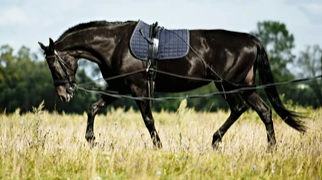Balance and core stabilisation are key for all horse riders; these aspects, essentially two sides of the same coin, not only keep us safely on board, but also allow us to be more explicit with our aids when riding. This can relate to the accuracy of the aid, for example using a leg aid at the spot that the horse responds to, based on its training; but can also relate to the subtly of an aid. For example, a barely-perceptible half halt based on the tautening of the rider’s abdominals and a subtle shift in shoulder position, as opposed to a visible rein aid.
Balance
is perhaps something we take for granted, if we’re more experienced riders. In
the days when we were learning, our balance was probably quite inconsistent,
occasionally hitting the sweet spot when the rising trot felt coordinated, or euphorically
landing from a jump with the weight flexibly anchored down into our ankles,
heels and stirrups.
Mutual
movement patterns
But as
we progress with our riding and the training of our horses, in whatever
discipline, we probably take balance for granted – yet we’re always influenced
by our own and our horse’s own individual movement patterns. That’s why riding
our own horse is like wearing a comfortable piece of clothing – we slip into
what we know – and that can include posture that isn’t optimal. For example, an
old hindleg injury that our horse has, and protects himself from aggravating,
can easily translate into us dropping a shoulder or sitting with our weight too
heavily on one seat bone. Often unconsciously!
Lovely
lungeing
Here we’d
like to highlight the importance of lunge lessons to identify our own
limitations where symmetry and balance are concerned, and improve core
stabilisation. This can be on your own horse, but it can also be revelatory to
have a lesson on a different horse, to experience a different movement pattern.
(Similarly, a lesson on a mechanical horse can have the same effect of being a
wake-up call to our own riding patterns – and these horses have the benefit of
being extremely balanced and straight!)
So let’s
look at the benefits of lunge lessons:
· They’re great to teach balance and
lightness to the rider, or brush up on these skills.
· Depending on how advanced the rider
is, most of these exercises can be done at all three gaits: the walk, trot, and
canter.
· Lunge lessons gives the instructor
control over the horse, so the rider can focus on their body, and become more
mindful of the process of riding.
· Additionally, the rider can focus on
themselves and their own needs and goals, not ‘training’ the horse, which is
often where their attention lies.
· Lunge lessons with a trainer (or a
session with an experienced friend who can lunge you safely) offer a chance to
go back to the basics, in order to reinforce a strong foundation of posture and
position.
Back
pain and mobility
Many
horse riders experience lower back pain, and working on your balance can
actually promote mobility and wellness in this area. Chronic or subacute
discomfort in the lower back is often called ‘subacute nonspecific low back
pain’ (NSLBP); years of horse riding and falls can cause such discomfort. Studies show that core stabilisation exercise can help reduce
pain, improve proprioception (awareness of the position and movement of the
body), and even reduce ‘fear of movement’ – that sense that we have to protect
a weak spot, in case it is aggravated. Commonly in the saddle, this can show up
as the rider maintaining a very contained trot, instead of embracing (and
moving comfortably with) a big, bold, forward-going trot; hunching the
shoulders to protect a weak area of our back (or to avoid ‘bosom-bounce’, for
women – the Derriere
Sportief Bra is a boon here); or tucking our tailbone
under too much, because extending the lumbar area (e.g. to create a driving
sitting trot, for example in a medium trot movement), is uncomfortable.
Having
lunge lessons therefore helps us face ‘fear of movement’ by encouraging and
developing the skill of core stabilisation, for example by doing work without
stirrups in a safe environment.
What to
wear
When
you’re training, consider the Derriere
Equestrian range, designed for both men and women. The Derriere Equestrian Treviso
Training breeches for example are great breeches to consider. They’re
designed to promote optimal comfort and performance, and work in
harmony with the Derriere
undergarments, ensuring all fabric surfaces come together in a
symbiosis that completely eliminates
chaffing, abrasions and discomfort! The material content
is a comfy mix of cotton, microfibre and elastane.
Talking
of undergarments, remember to equip yourself with some comfy, supportive riding
underwear. For ultimate comfort in the saddle, so you’re not thinking
about discomfort when trying to hone your balance and stabilisation, try the Derriere Equestrian Performance Padded
Panty, which
is designed to eradicate seamlines visible through breeches and ensure no
rubbing, chaffing or abrasions are created. Incorporating the Derriere
Equestrian Padded Support System (DEPSS), the garments protect the
perineal area (the bit between the pubic arch and the tail bone), from
discomfort, and also prevent rubbing, due to innovative stitched seams. In
particular, if you’re a male rider taking lunge lessons, you may find that
having subtle, extra padding in your undergarments improves your intuitive
riding, as you may not ‘brace’ to protect yourself in terms of ‘fear of
movement’, and can instead go with the horse’s movement more naturally.





No comments:
Post a Comment